Summary
Once you have collected and processed the stand level data the next step is to use it to understand what is happening in the stand and then to specify silvicultural interventions. At a recent workshop in North West England Forest District a group of pioneers met to share their experience. This experience suggested that the main benefits from monitoring covers:
- Regeneration
- Stand structure
- Presentation.
Regeneration
Stand level data displayed by a GIS:
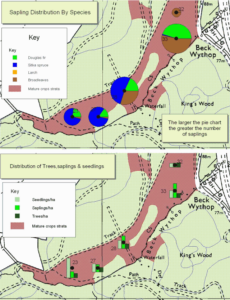
Objective information is produced on species composition, size, distribution and browsing damage on regeneration. This is useful because many forest managers:
- Over-estimate the amount of regeneration in a stand
- Under-estimate the level of browsing (often this will be one of the main reasons why there is little, or no, regeneration)
- Give emphasis to seedling regeneration, especially where there is a lot of it, rather than saplings that are much more likely to become part of the new stand
- Only focus on the preferred target species to regenerate instead of considering the wider species mix that will develop
- Have no way of assessing the distribution of regeneration (this can have important implications for thinning CCF stands). Some users linked their stand level data to a Graphical Information System (GIS) by using a handheld Global Positioning System (GPS). This has enabled them to examine the data spatially; an example is shown on the right.
Stand structure
Screenshot displaying diameter distribution:
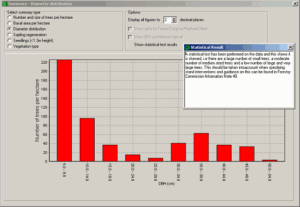
Objective information is presented on species composition, basal area and diameter distribution of stands. This can be useful for two main reasons:
- The structure of a stand is critically important when deciding how to thin it.
The software allows the forest manager to test if the diameter distribution is ‘symmetric’ (similar to a normal distribution) or ‘skewed’ as shown in the example on the right. As can be seen, a skewed distribution would have many small trees, a moderate number of medium trees and a low number of large trees, and is similar to the ‘reverse-j distribution’ much discussed as an option for managing continuous cover forests. If the stand has a symmetric diameter distribution this must be taken into account when thinning the stand, especially if the aim is to develop a structure with three or more canopy strata. - It enables forest mangers to be objective about their approach to CCF management and record the results of their interventions.
At present we have some information concerning the correct range of basal areas to use when transforming stands (see Forestry Commission Information Note 40) but have little understanding of how this will vary with site and during different stages of transformation. It is imperative that we develop this experience and share it.
Presentation
The results of monitoring can be used to present a professional approach to Continuous Cover Forestry management to potential or existing clients, team members or external contacts.
This information was first published in the January 2005 edition of Forestry and British Timber.
Continuous cover silviculture – collecting stand level data
Mason, B. and Kerr, G. (2004) Transforming even-aged conifer stands to continuous cover management. Forestry Commission Information Note 40 (Revised). Forestry Commission, Edinburgh.
Kerr, G., Mason, B., Boswell, R. (2003) A sampling system to monitor the transformation from even-aged stands to continuous cover. Forestry, 76(4): 425-435.
Kerr, G. (2002) Uneven-aged silviculture: putting ideas into practice. Quarterly Journal of Forestry, 96(2):111-116.
Kerr, G., Mason, B., Boswell, R. & Pommerening, A. (2002) Monitoring the transformation of even-aged stands to continuous cover management. Forestry Commission Information Note 45. Forestry Commission, Edinburgh.
Mason, B., Kerr, G. and Simpson, J. (1999) What is Continuous Cover Forestry? Forestry Commission Information Note 29. Forestry Commission, Edinburgh. 8pp.
What’s of interest

Software to support the transformation to Continuous Cover Forestry is available free from Forest Research.
Continuous cover silviculture – silvicultural interventions
Stratifying the area into blocks
The crucial first step to collect the data is to stratify the area into blocks that have common site factors and are to be managed as a single unit. In general the bigger, the better, as this will help reduce costs. Within each block, data are collected from fixed-area plots where the plot area is selected to assess a minimum number of trees.
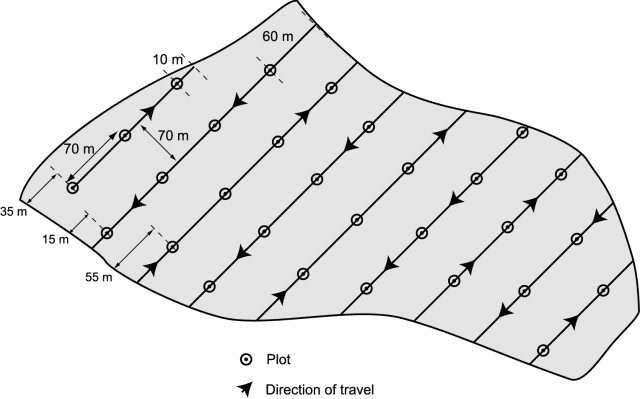 Locating plots on a systematic grid within each block where data is to be collected
Locating plots on a systematic grid within each block where data is to be collected
Plots are located on a systematic grid covering the whole area and can be located using a compass and pacing.
The plots can be temporary or permanently marked depending on a number of factors; most people who have used the system so far feel that the advantages of permanent plots outweigh their disadvantages.
The main assessments in each plot are:
- Species
- Number and diameter of trees
- Species and number of saplings
- Species and number of seedlings
- Browsing damage
- Vegetation type and cover.
Saplings are woody plants at least 130 cm in height and less than 7 cm diameter at breast height. Saplings are important because given good silviculture there is a greater than 90% chance of them surviving to maturity.
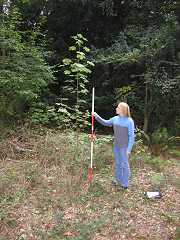
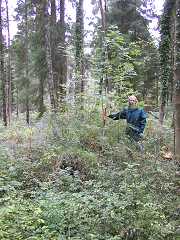
Nomenclature and size criteria for seedlings, saplings and trees
| Diameter at breast height (cm) | Height (cm) | |
|---|---|---|
| Seedling | n/a | <130 |
| Sapling | <7 | ≥130 |
| Tree | ≥7 | ≥130 |
Processing the data
Once the data have been collected they can be processed and examined using the software developed by Forest Research.
In the development of the software, the opportunity has been taken to allow other information concerning the transformation of an area to be recorded alongside the monitoring data. Hence the system allows the transformation plan, diary notes, fixed-point photographs and information on stand location to be stored.
The software enables information on the following to be displayed:
- Species, number and size of trees
- Basal area per species
- Diameter distribution
- Sapling and seedling regeneration
- Vegetation type and cover.
For example:
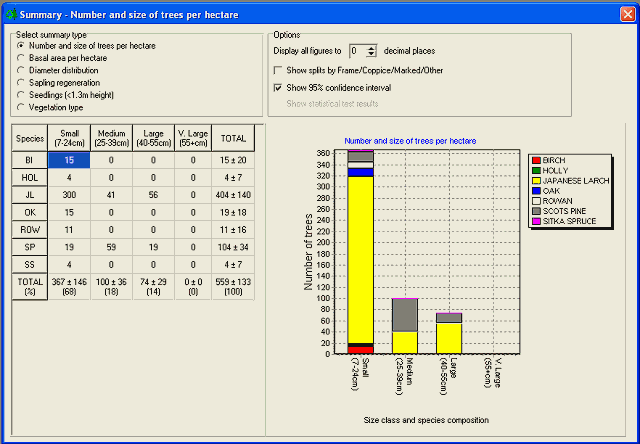
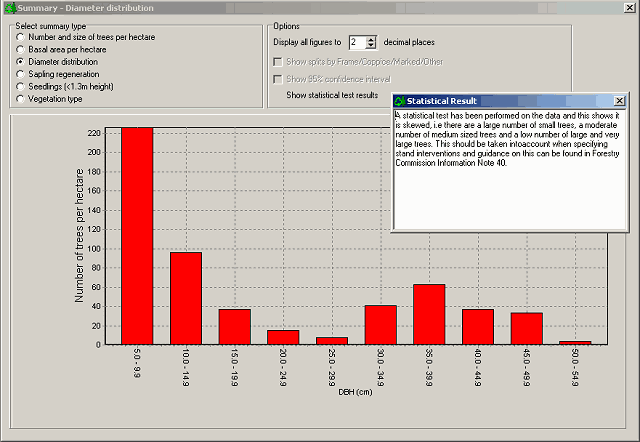
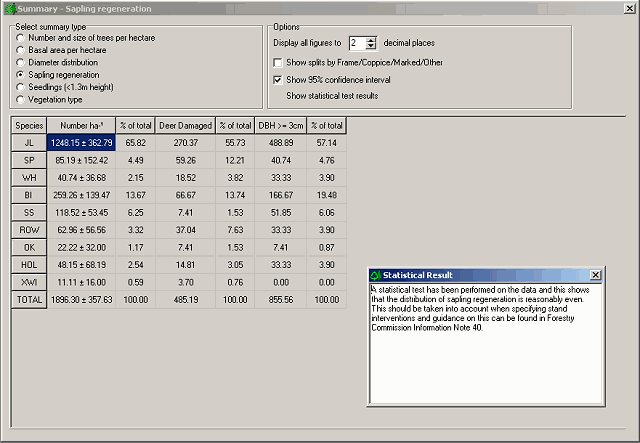
The above screenshots illustrate data from a stand with an overstorey of Scots pine and Japanese larch in Wykeham Forest, Yorkshire. The stand has a good structure for immediate introduction of Continuous Cover Forestry and the density and species composition of the saplings will ensure good recruitment of trees over the next 10 years assuming appropriate thinning.
This information was first published in the January 2005 edition of Forestry and British Timber
What’s of interest
Monitoring the transformation of even-aged stands to continuous cover management
Forestry Commission Information Note 45 describes the approach in detail

Software to support the transformation to Continuous Cover Forestry is available free from Forest Research.
General Content
What’s of interest

Monitoring the Transformation of Even-aged Stands to Continuous Cover Management
Forestry Commission Information Note 45 describes the approach in detail

Software to support the transformation to Continuous Cover Forestry is available free from Forest Research.
